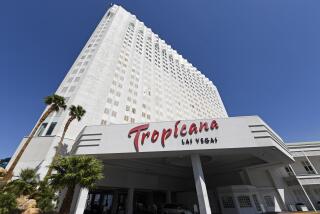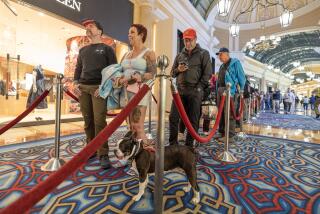Analysis : Pimlico’s Glitzy ‘Palace’ Is a Sign of Revival
- Share via
BALTIMORE — Pimlico opened its new Sports Palace to the public this week -- and it’s a knockout. It is as stunning to see such a glitzy facility in the midst of this cavernous old racetrack as it would be to find it in Bangladesh.
This is the first major improvement that Frank De Francis and his partners have made since they bought the track in late 1986. “Because Pimlico didn’t have anything yet, we wanted to knock everybody’s hats off with the Sports Palace,” said Lynda O’Dea, who designed it.
The new facility is, of course, modeled after the Sports Palace at Laurel that has attracted widespread attention in the racing industry. But the room at Laurel had some negatives because of its location -- it was too far from the clubhouse and the paddock, and it was completely enclosed. A patron could spend the day without seeing a live horse. But there was a perfect spot for Pimlico’s Sports Palace -- the fourth floor of the clubhouse.
Sports Palace patrons can step out to a glass-enclosed terrace, with 160 executive-style swivel chairs, and watch the horses run live. Or they can watch the races on any three giant screens inside the Sports Palace; dining tables face two of the screens, a large circular bar faces the other.
As at Laurel, the Pimlico Sports Palace has banks of computers where horseplayers can study statistical data and apply it to the day’s races; also television monitors where they can watch reruns of previous races. For the benefit of neophytes, Pimlico has a “Racing Information Center” that offers short film presentations on basics of handicapping -- speed, class, pace, breeding, etc.
The decor of the room is, in a word, dramatic. O’Dea utilized Pimlico’s traditional colors of black and yellow with touches of plum and teal. Walls are black with brass moldings. Tables have black and gold tiles imported from Italy. Three large, elegant chandeliers hang over the room.
People who are relative newcomers to Maryland racing might not be so dazzled by such innovations as old-timers are. After all, casinos routinely offer their customers such style and comfort. But for horseplayers who came here when the Cohen family owned the place and General Manager Chick Lang was running it, such luxury would have been unimaginable.
The other day I was cleaning out a closet and came across a yellowing copy of The Washington Post with a column I wrote on a day after Pimlico had drawn a pitiful crowd of 4,461.
It said: “If Maryland racing were a person instead of a multimillion-dollar industry, it might be time to summon a priest to administer the last rites.
There is no mystery about the reasons for the decline of Maryland’s once-proud racing circuit. Facilities at most of the track’s are dreadful. Bowie is a despicable eyesore; Timonium is bush league, Pimlico’s grandstand is a gloomy, smoky glass box. ... “
This was not ancient history. This was March 1984, and the racing industry definitely was headed for minor-league status, largely because track managements refused to treat their customers decently and were giving those customers away.
De Francis bought Laurel, and then Pimlico, with the hope of luring back these defectors by improving the quality of his product, and the construction of Laurel’s Sports Palace was his first big move in that direction.
The whole idea of the Sports Palace -- with its Las Vegas sports ticker and its abundance of handicapping aids -- was to appeal to serious bettors. It was a sign that this new management knew its customers and was trying to cater to them.
This attitude brought bigger crowds, then bigger purses, then better-quality racing, and finally national recognition that Maryland is the most booming sector of American racing.
So the new Pimlico Sports Palace evokes enthusiasm not only because it promises to be a very pleasant, comfortable place to play the horses. It is a vivid symbol of the whole revival of racing here.
More to Read
Go beyond the scoreboard
Get the latest on L.A.'s teams in the daily Sports Report newsletter.
You may occasionally receive promotional content from the Los Angeles Times.










